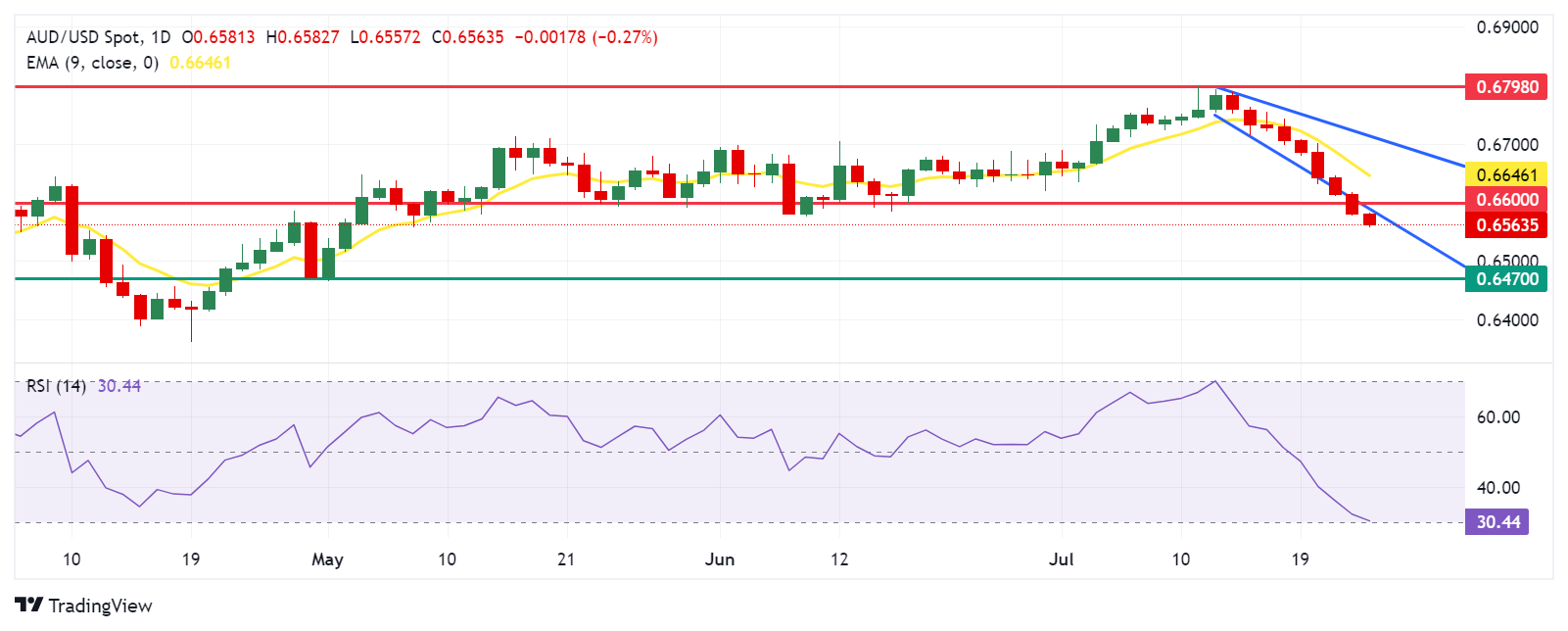Australian Dollar extends losing streak due to falling prices of energy, metals
- The Australian Dollar depreciates due to the stark decline in prices of prices of oil, iron ore, and copper.
- The AUD faced challenges as recent PMI data showed that Australia's business activity cooled to a six-month low in July.
- The US Dollar may struggle due to a decline in Treasury yields.
The Australian Dollar (AUD) continues its losing streak for the ninth consecutive day on Thursday, primarily due to declining prices of oil, iron ore, and copper. As Australia is a net exporter of energy and metals, its currency is particularly sensitive to fluctuations in commodity prices.
The AUD also faced pressure from recent Purchasing Managers Index (PMI) data, which showed that Australia's business activity cooled to a six-month low in July. Manufacturing activity remained in contraction, and growth in the services sector slowed.
The Aussie Dollar may limit its downside as the Reserve Bank of Australia (RBA) is expected to delay easing its policy tightening compared to other major central banks due to persistent inflationary pressures and a tight labor market. Futures markets currently imply a 20% probability that the RBA could hike interest rates at its August meeting.
The AUD/USD pair also faced pressure from a strengthening US Dollar (USD) as investors prepared for upcoming US GDP and PCE inflation data. Recent US PMI data indicated that private-sector activity expanded at a faster pace in July, highlighting the resilience of US growth despite higher interest rates. This data provides the Federal Reserve (Fed) with some flexibility to maintain its restrictive policy stance if inflation does not show signs of slowing.
Daily Digest Market Movers: Australian Dollar declines due to cooling business activity
- The S&P Global US Services PMI increased to a reading of 56.0 in July, the highest in 28 months, up from a 55.3 reading in June and exceeding market expectations of 55.3. Meanwhile, the Composite PMI rose to f 55.0 from the previous 54.8 reading, marking the highest reading since April 2022 and indicating sustained growth over the past 18 months.
- Sluggish economic activity in China has put additional selling pressure on the Aussie Dollar. Concerns about the weak Chinese economy were heightened by an unexpected rate cut from the People's Bank of China (PBoC) on Monday. The People’s Bank of China (PBOC), cut the one-year Medium-term Lending Facility (MLF) rate from 2.50% to 2.30% on Thursday. Additionally, the Bank of China, one of the world's largest banks, announced a 10-20 basis points cut in time deposit rates. Any change in the Chinese economy could impact the Australian markets as both countries are close trade partners.
- Australia's Judo Bank Manufacturing PMI improved to 47.4 in July from 47.2 in June. Meanwhile, the Services PMI dropped to 50.8 in July from 51.2 in June. The Composite PMI also declined, falling to 50.2 in July from 50.7 in June.
- Media reports say that Vice President Kamala Harris has just passed 1,976 Democratic delegates to secure the party's presidential nomination. Harris is now the Democratic Party’s Presumptive Nominee for November’s Presidential Election.
- Federal Reserve Bank of New York President John Williams stated on Friday that the long-term trends that caused declines in neutral interest rates before the pandemic continue to prevail. Williams noted, "My own Holston-Laubach-Williams estimates for r-star in the United States, Canada, and the Euro area are about the same level as they were before the pandemic," according to Bloomberg.
- Reuters cited Sean Langcake, head of macroeconomic forecasting for Oxford Economics Australia, saying, "The current pace of employment growth suggests demand is resilient and cost pressures will remain. We think the RBA will stay the course and keep rates on hold, but August is certainly a live meeting."
Technical Analysis: Australian Dollar falls to near 0.6550
The Australian Dollar trades around 0.6570 on Thursday. The daily chart analysis indicates that the AUD/USD pair has broken below the descending channel, signaling the strengthening of a bearish bias. The 14-day Relative Strength Index (RSI) is positioned at the level of 50, suggesting an oversold condition for the currency pair and pointing to a potential correction soon.
The AUD/USD pair could find support around the psychological level of 0.6500, followed by a throwback support at 0.6470.
On the upside, key resistance is at the lower boundary of the descending channel at 0.6590, followed by the psychological level of 0.6600. A return to the descending channel may weaken the bearish bias and support the AUD/USD pair in testing the nine-day Exponential Moving Average (EMA) at 0.6646. A breakthrough above this level could lead the pair to test the upper boundary of the descending channel around 0.6715, potentially aiming for a six-month high of 0.6798.
AUD/USD: Daily Chart

Australian Dollar PRICE Today
The table below shows the percentage change of Australian Dollar (AUD) against listed major currencies today. Australian Dollar was the weakest against the Japanese Yen.
| USD | EUR | GBP | JPY | CAD | AUD | NZD | CHF | |
|---|---|---|---|---|---|---|---|---|
| USD | 0.00% | 0.13% | -0.75% | 0.09% | 0.39% | 0.16% | -0.14% | |
| EUR | -0.01% | 0.13% | -0.75% | 0.08% | 0.38% | 0.15% | -0.15% | |
| GBP | -0.13% | -0.13% | -0.87% | -0.05% | 0.27% | 0.02% | -0.28% | |
| JPY | 0.75% | 0.75% | 0.87% | 0.82% | 1.13% | 0.88% | 0.60% | |
| CAD | -0.09% | -0.08% | 0.05% | -0.82% | 0.31% | 0.08% | -0.23% | |
| AUD | -0.39% | -0.38% | -0.27% | -1.13% | -0.31% | -0.22% | -0.54% | |
| NZD | -0.16% | -0.15% | -0.02% | -0.88% | -0.08% | 0.22% | -0.31% | |
| CHF | 0.14% | 0.15% | 0.28% | -0.60% | 0.23% | 0.54% | 0.31% |
The heat map shows percentage changes of major currencies against each other. The base currency is picked from the left column, while the quote currency is picked from the top row. For example, if you pick the Australian Dollar from the left column and move along the horizontal line to the US Dollar, the percentage change displayed in the box will represent AUD (base)/USD (quote).
Australian Dollar FAQs
One of the most significant factors for the Australian Dollar (AUD) is the level of interest rates set by the Reserve Bank of Australia (RBA). Because Australia is a resource-rich country another key driver is the price of its biggest export, Iron Ore. The health of the Chinese economy, its largest trading partner, is a factor, as well as inflation in Australia, its growth rate and Trade Balance. Market sentiment – whether investors are taking on more risky assets (risk-on) or seeking safe-havens (risk-off) – is also a factor, with risk-on positive for AUD.
The Reserve Bank of Australia (RBA) influences the Australian Dollar (AUD) by setting the level of interest rates that Australian banks can lend to each other. This influences the level of interest rates in the economy as a whole. The main goal of the RBA is to maintain a stable inflation rate of 2-3% by adjusting interest rates up or down. Relatively high interest rates compared to other major central banks support the AUD, and the opposite for relatively low. The RBA can also use quantitative easing and tightening to influence credit conditions, with the former AUD-negative and the latter AUD-positive.
China is Australia’s largest trading partner so the health of the Chinese economy is a major influence on the value of the Australian Dollar (AUD). When the Chinese economy is doing well it purchases more raw materials, goods and services from Australia, lifting demand for the AUD, and pushing up its value. The opposite is the case when the Chinese economy is not growing as fast as expected. Positive or negative surprises in Chinese growth data, therefore, often have a direct impact on the Australian Dollar and its pairs.
Iron Ore is Australia’s largest export, accounting for $118 billion a year according to data from 2021, with China as its primary destination. The price of Iron Ore, therefore, can be a driver of the Australian Dollar. Generally, if the price of Iron Ore rises, AUD also goes up, as aggregate demand for the currency increases. The opposite is the case if the price of Iron Ore falls. Higher Iron Ore prices also tend to result in a greater likelihood of a positive Trade Balance for Australia, which is also positive of the AUD.
The Trade Balance, which is the difference between what a country earns from its exports versus what it pays for its imports, is another factor that can influence the value of the Australian Dollar. If Australia produces highly sought after exports, then its currency will gain in value purely from the surplus demand created from foreign buyers seeking to purchase its exports versus what it spends to purchase imports. Therefore, a positive net Trade Balance strengthens the AUD, with the opposite effect if the Trade Balance is negative.

